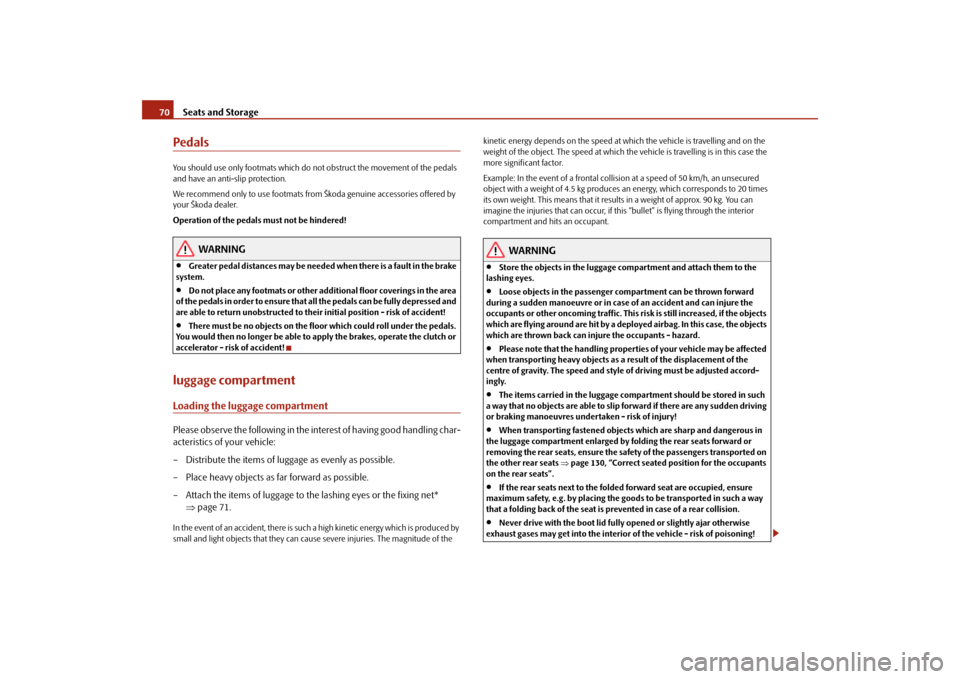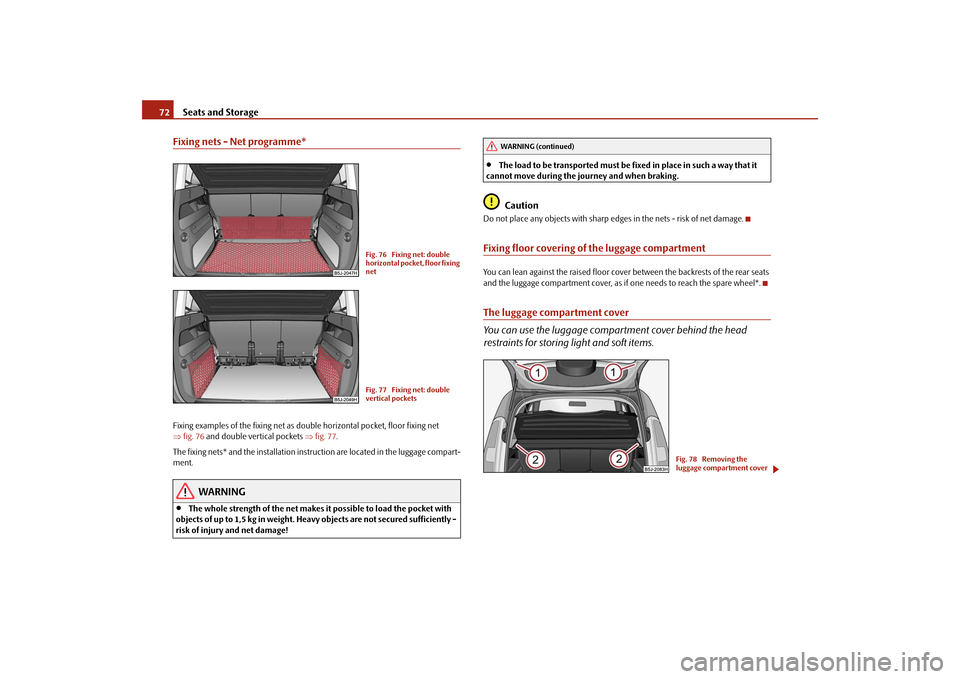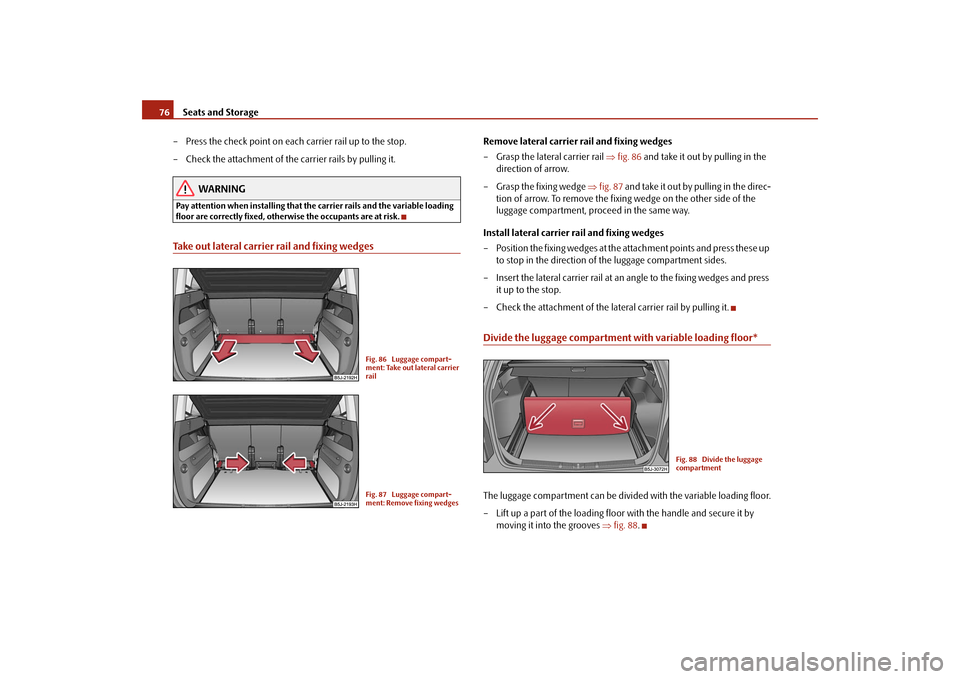2009 SKODA ROOMSTER ECU
[x] Cancel search: ECUPage 50 of 263

Unlocking and locking49
Using the system
Safety
Driving Tips
General Maintenance
Breakdown assistance
Praktik
Technical Data
Interior monitor*
and towing protection
monitoring*The interior monitor and the towing protection monitoring detect
movements inside the vehicle interior and then trigger the alarm.The interior monitor and the towing protection monitoring are operated
with the button
. You can switch the interior monitor and the towing
protection monitoring off if there is a possibility that movements from
(e.g. children or animals) inside the vehicle interior or if the vehicle must
be transported (e.g. by train or ship) or towed, might trigger the alarm.
Switch off the interior monitor and towing protection monitoring
– Switch off the ignition.
– Press the button
on the driver door ⇒fig. 42.
– Lock the vehicle within 30 seconds. The interior monitor and the
towing protection monitoring are switched off.
The interior monitor and the towing protection monitoring are switched on again
automatically the next time the car is locked.
Note
•
You can also switch off the interior monitor and the towing protection moni-
toring, by deactivating the safe securing system ⇒page 43.
•
When the ignition key is removed or a door is opened, the symbol in the button
lights up red.
•
Lighting up of the symbol in the button does not confirm that the interior
monitor and the towing protection monitoring are switched on.
Electrical power windows*Buttons for electrical power windows
Fig. 42 Interior monitor
pushbutton
Fig. 43 Buttons on the
driver's doorFig. 44 Button on the rear
door
s29g.4.book Page 49 Wednesday, June 17, 2009 9:54 AM
Page 66 of 263

Seats and Storage65
Using the system
Safety
Driving Tips
General Maintenance
Breakdown assistance
Praktik
Technical Data
– Move the head restraint downwards if required by pressing the locking
button ⇒fig. 62 and by pressing with the other hand the head
restraint downwards.
Removing and installing a head restraint
– Pull the head restraint out of the seat backrest as far as the stop.
– Press the locking button in the direction of arrow ⇒fig. 62 and pull
the head restraint out.
– To re-insert the head restraint, push it down into the seat backrest far
enough until you hear the locking button engage.The position of the front, rear outer head restraints and the rear middle head
restraint* is adjustable for height.
The head restraints must be adjusted to match the size of the seat occupant.
Correctly adjusted head restraints together with the seat belts offer effective
protection for the occupants ⇒page 128.
WARNING
•
The head restraints must be correctly adjusted in order to offer effective
protection for the occupants in the event of an accident.
•
Do not drive under any circumstance with removed head restraints - risk
of injury!
Heating the front seats*The seating and leaning surfaces of the driver and front passenger seat
can be heated when the ignition is switched on.
Front seats
– By pressing the rocker switch in the position or switch on the
front seat heating to 25 % or 100 % of its power output ⇒fig. 63.
– To switch off the heating shift the rocker switch into the horizontal
position.
WARNING
•
If, as an occupant, you have a subdued pain and/or temperature sensi-
tivity, e.g. through medication, paralysis or because of chronic illness (e.g.
diabetes), we recommend not to use the seat heating of the driver or front
passenger seat. This can lead to burns on the back, the posterior and the legs
which are difficult to heal. If the seat heating is used, we recommend to make
regular breaks in your journey when driving long distances, so that the body
can recuperate from the stress of the journey. Please consult your doctor,
who can evaluate your specific condition.
Fig. 63 Rocker switch: Front
seat heatingA1
A2
s29g.4.book Page 65 Wednesday, June 17, 2009 9:54 AM
Page 68 of 263

Seats and Storage67
Using the system
Safety
Driving Tips
General Maintenance
Breakdown assistance
Praktik
Technical Data
Adjusting the seat backrestAdjust the angle of the seat backrest
– Pull the lever ⇒fig. 66 and adjust the desired angle of the seat
backrest.Folding seats forwards
Fold seats fully forwards and secure
– Open the guide loop for the seat belt on the side of the outer seats and
put the belt tongue into the opening on the respective side trim panel
- safety holder.
– Move the seat as far as possible to the rear ⇒page 66.
–Pull the lever ⇒page 67, fig. 66 and fold the seat backrest fully
fowards.
–Pull the lever ⇒fig. 67 up and then fold the seat fully forwards.
– Secure the folded forward seat with the aid of the fixing belt to a guide
rod of the head restraint for the front seat ⇒fig. 68.
WARNING
•
Immediately secure the folded forward seat with the aid of the fixing belt
to a guide rod of the head restraint for the front seat - there is a risk of injury
as soon as the vehicle starts off.
•
If the seat is not in the rear end position, damage can occur to the locking
bolts if the seat is unlocked.
Fig. 66 Adjusting the seat
backrestFig. 67 Folding seat fully
forwards
Fig. 68 Secure folded
forward seats
s29g.4.book Page 67 Wednesday, June 17, 2009 9:54 AM
Page 70 of 263

Seats and Storage69
Using the system
Safety
Driving Tips
General Maintenance
Breakdown assistance
Praktik
Technical Data
Move seats into the initial positionLocking seats and folding back into position
– If the seat is removed, first of all position it on the guide and lock the
seat ⇒page 68, fig. 71. Check for yourself that the seat is correctly
locked by pulling it up.
– Fold the seat into the horizontal position until it is heard to lock. Check
for yourself that the seat can no longer be lifted by pulling it up.
– Push the lever ⇒fig. 72 and fold the backrest back into position.
Check for yourself that the seat backrest is engaged.
– Take the belt tongue out of the safety holder.
– C l o s e th e g u id e l o o p o f t h e s ea t b el t o n th e s i de o f t h e o u te r s e a t s u n t il
it is heard to lock.
WARNING
•
The belt locks and the belts must be in their original position after folding
back the seat cushions and the seat backrests - they must be ready to use.
•
The seat backrests must be securely interlocked in position so that no
objects in the luggage compartment can slide into the passenger compart-
ment if there is sudden braking - risk of injury!
•
When folding the seat backrest always make sure that it has safely locked
into position, this is confirmed by the position and a visible marking on the
cover of the lever.Note
The seat belts of the outer seats must always be guided through the guide loops
next to the head restraints. Otherwise the seat belts can slip behind the seat.Folding table on the middle seat backrest*– The middle seat backrest can be folded ⇒page 67, “Folding seats
forwards” forwards and used as armrest or table with cup holder
⇒fig. 73.
– You can place two cups or beverage cans into the recesses.
NoteIf the middle rear seat backrest should be folded forward for lengthy periods, then
make sure that the belt locks are not located below it - this can result in permanent
damage to the upholstery.
Fig. 72 Folding the seat
backrest back into position
WARNING (continued)
Fig. 73 Rear seats: Armrest
s29g.4.book Page 69 Wednesday, June 17, 2009 9:54 AM
Page 71 of 263

Seats and Storage 70PedalsYou should use only footmats which do not obstruct the movement of the pedals
and have an anti-slip protection.
We recommend only to use footmats from Škoda genuine accessories offered by
your Škoda dealer.
Operation of the pedals must not be hindered!
WARNING
•
Greater pedal distances may be needed when there is a fault in the brake
system.
•
Do not place any footmats or other additional floor coverings in the area
of the pedals in order to ensure that all the pedals can be fully depressed and
are able to return unobstructed to their initial position - risk of accident!
•
There must be no objects on the floor which could roll under the pedals.
You would then no longer be able to apply the brakes, operate the clutch or
accelerator - risk of accident!
luggage compartmentLoading the luggage compartmentPlease observe the following in the interest of having good handling char-
acteristics of your vehicle:
– Distribute the items of luggage as evenly as possible.
– Place heavy objects as far forward as possible.
– Attach the items of luggage to the lashing eyes or the fixing net*
⇒page 71.In the event of an accident, there is such a high kinetic energy which is produced by
small and light objects that they can cause severe injuries. The magnitude of the kinetic energy depends on the speed at which the vehicle is travelling and on the
weight of the object. The speed at which the vehicle is travelling is in this case the
more significant factor.
Example: In the event of a frontal collision at a speed of 50 km/h, an unsecured
object with a weight of 4.5 kg produces an energy, which corresponds to 20 times
its own weight. This means that it results in a weight of approx. 90 kg. You can
imagine the injuries that can occur, if this “bullet” is flying through the interior
compartment and hits an occupant.
WARNING
•
Store the objects in the luggage compartment and attach them to the
lashing eyes.
•
Loose objects in the passenger compartment can be thrown forward
during a sudden manoeuvre or in case of an accident and can injure the
occupants or other oncoming traffic. This risk is still increased, if the objects
which are flying around are hit by a deployed airbag. In this case, the objects
which are thrown back can injure the occupants - hazard.
•
Please note that the handling properties of your vehicle may be affected
when transporting heavy objects as a result of the displacement of the
centre of gravity. The speed and style of driving must be adjusted accord-
ingly.
•
The items carried in the luggage compartment should be stored in such
a way that no objects are able to slip forward if there are any sudden driving
or braking manoeuvres undertaken - risk of injury!
•
When transporting fastened objects which are sharp and dangerous in
the luggage compartment enlarged by folding the rear seats forward or
removing the rear seats, ensure the safety of the passengers transported on
the other rear seats ⇒page 130, “Correct seated position for the occupants
on the rear seats”.
•
If the rear seats next to the folded forward seat are occupied, ensure
maximum safety, e.g. by placing the goods to be transported in such a way
that a folding back of the seat is prevented in case of a rear collision.
•
Never drive with the boot lid fully opened or slightly ajar otherwise
exhaust gases may get into the interior of the vehicle - risk of poisoning!
s29g.4.book Page 70 Wednesday, June 17, 2009 9:54 AM
Page 73 of 263

Seats and Storage 72Fixing nets - Net programme*Fixing examples of the fixing net as double horizontal pocket, floor fixing net
⇒fig. 76 and double vertical pockets ⇒fig. 77.
The fixing nets* and the installation instruction are located in the luggage compart-
ment.
WARNING
•
The whole strength of the net makes it possible to load the pocket with
objects of up to 1,5 kg in weight. Heavy objects are not secured sufficiently -
risk of injury and net damage!
•
The load to be transported must be fixed in place in such a way that it
cannot move during the journey and when braking.Caution
Do not place any objects with sharp edges in the nets - risk of net damage.Fixing floor covering of the luggage compartmentYou can lean against the raised floor cover between the backrests of the rear seats
and the luggage compartment cover, as if one needs to reach the spare wheel*.The luggage compartment cover
You can use the luggage compartment cover behind the head
restraints for storing light and soft items.
Fig. 76 Fixing net: double
horizontal pocket, floor fixing
netFig. 77 Fixing net: double
vertical pockets
WARNING (continued)
Fig. 78 Removing the
luggage compartment cover
s29g.4.book Page 72 Wednesday, June 17, 2009 9:54 AM
Page 77 of 263

Seats and Storage 76
– Press the check point on each carrier rail up to the stop.
– Check the attachment of the carrier rails by pulling it.
WARNING
Pay attention when installing that the carrier rails and the variable loading
floor are correctly fixed, otherwise the occupants are at risk.Take out lateral carrier rail and fixing wedges
Remove lateral carrier rail and fixing wedges
– Grasp the lateral carrier rail ⇒fig. 86 and take it out by pulling in the
direction of arrow.
– Grasp the fixing wedge ⇒fig. 87 and take it out by pulling in the direc-
tion of arrow. To remove the fixing wedge on the other side of the
luggage compartment, proceed in the same way.
Install lateral carrier rail and fixing wedges
– Position the fixing wedges at the attachment points and press these up
to stop in the direction of the luggage compartment sides.
– Insert the lateral carrier rail at an angle to the fixing wedges and press
it up to the stop.
– Check the attachment of the lateral carrier rail by pulling it.Divide the luggage compartment with variable loading floor*The luggage compartment can be divided with the variable loading floor.
– Lift up a part of the loading floor with the handle and secure it by
moving it into the grooves ⇒fig. 88.
Fig. 86 Luggage compart-
ment: Take out lateral carrier
railFig. 87 Luggage compart-
ment: Remove fixing wedges
Fig. 88 Divide the luggage
compartment
s29g.4.book Page 76 Wednesday, June 17, 2009 9:54 AM
Page 78 of 263

Seats and Storage77
Using the system
Safety
Driving Tips
General Maintenance
Breakdown assistance
Praktik
Technical Data
Bicycle carrier*Install cross member– Remove the rear seats or fold the seats fully forwards, in order to make
available the necessary space in the luggage compartment
⇒page 68.
– Release the fixtures at the ends of the cross member by slightly
pulling up the securing screws .
– Position the cross member with the fixed (not pulled out) part onto
the (in direction of travel) right lashing eye and then the pull-out part
onto the left lashing eye.
– Secure the fixture to both sides and lock the fixing screws in
place.
– Tighten the fixing screws up to the stop.
– Check the attachment of the cross member by pulling it.
WARNING
When transporting the bicycles in the luggage compartment, ensure the
safety of the passengers transported on the rear seats ⇒page 130, “Correct
seated position for the occupants on the rear seats”.Install bicycle carrier– Position the approved bicycle carrier on the cross member, after
pulling up the screw push the frame side rail (alu-part) towards the
cross member and screw the screw into the nut ⇒fig. 90.
– Slacken the screw on the moveable part of the bicycle carrier and
pull out, then position the moveable part of the carrier, depending on
bicycle size, into one of the three possible positions.
– Insert the screw into the desired position and tighten.
Fig. 89 Install cross member
AB
AC
AA
AB
AC
AC
Fig. 90 Install bicycle carrier
AA
AA
ABAB
s29g.4.book Page 77 Wednesday, June 17, 2009 9:54 AM